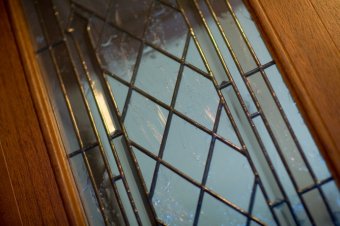Decorative panes
Stained glass
Customers very often choose, particularly for interior and exterior doors, decorative panes in the form of stained glass made of pieces of coloured glass set in leaden frames embedded between iron bars. The frames are a contour of a drawing, while the line drawing on glass or painting it with transparent paint emphasises distinctive elements (head, eyes, hands, garments folding, shading, etc.)
For more information on stained glass used in Wiktorczyk wood products, please visit http://www.witraz.pl/
Ornaments
Ornamental glass is a half translucent glass obtained in the process of rolling liquid glass between two cylinders. A pattern is engraved on one of the cylinders and in the manufacturing process it is embossed on the glass. Ornamental glass is produced as clear, coloured or reinforced glass.
Ornamental glass is ideal for interior doors, exterior doors and windows manufactured by ABA WIKTORCZYK. It provides a bit of discretion and intimacy thanks to its interesting texture.
Visit: gallery of ornaments
Reflective glass
Reflective glass is a clear glass or glass tinted brown, grey, green or blue. It is covered with a layer of hard metal oxides in order to obtain the proper reflective properties, control sunlight penetration into rooms and limit solar energy transmittance to a room.
Such glass may be used as single or insulated, depending on the type of coating. This type of glass is mainly used for conservatories or large glazing projects.
Anti-burglary glass
CLIMAPLUS STADIP PROTECT is an insulated pane that provides varied anti-burglary protection classes depending on the structure. PROTECT STADIP CLIMAPLUS glass panes simultaneously reduce the risk of injury from shattered glass in case of it being broken and the risk of falling – if a piece of glass is broken, the pieces are held by a PVB film and the hole remains closed or of minimal size.
Due to the fact that the pane that is responsible for this safety feature is thicker than the other panes in the set and includes a PVB film that has certain blocking properties, CLIMAPLUS STADIP PROTECT has better noise insulation parameters.
Products in the PROTECT range filter most UV rays. They provide maximum protection of all items equipment subject to fading due to exposure to sunlight (e.g. shop windows, drapes, carpets).
Classification and requirements for glass panes with increased resistance and functional parameters, with examples of use.
Sound absorption
In order to increase the comfort level of using flats and offices, especially in the vicinity of sources of significant noise, such as streets, industrial sites, airports, etc. and in the interiors of buildings in order to block noise leakage between rooms, glass manufacturers have introduced another type of glass whose task is to reduce the intensity of sound.
Basic low-emission insulated glass Float 4mm/16mm + argon/float4 offers sound absorption at a level of 32 dB, but this is often insufficient and then insulated glass with increased sound absorption is used. Such glass is usually laminated safety or anti-burglary glass with a special film that also absorbs sound and reduces its intensity.
The thickness of monolithic glass panes used, the space between the panes and the type of gas used to fill this space are all factors in the sound absorption of insulated windows. Ask a question to obtain more information.

Resistance class of security panes
| Resistance class | Testing method | Drop height [cm] | Number of hit |
|---|---|---|---|
| P1A | Hitting with a steel ball | 150 | 3 in a triangle |
| P2A | Hitting with a steel ball | 300 | 3 in a triangle |
| P3A | Hitting with a steel ball | 600 | 3 in a triangle |
| P4A | Hitting with a steel ball | 900 | 3 in a triangle |
| P5A | Hitting with a steel ball | 900 | 3×3 in a triangle |
| P6B | Hitting with a hammer and axe | - | 30⁄50 |
| P7B | Hitting with a hammer and axe | - | 51⁄70 |
| P8B | Hitting with a hammer and axe | - | more than 70 |
Use of security glazing
| Resistance class | Functional parameters | Examples of use |
|---|---|---|
| P1A | Protect against cuts from broken glass, make it difficult to break the pane when the window or door suddenly close | Houses, schools, offices, manufacturing plants, interior doors, windows on the ground floor and higher |
| P2A | Protect against cuts. Can provide temporary protection against burglary without preparation | Kiosks, houses, windows of ground floor apartments, hotel and office windows, commercial buildings with low protected value, sports halls |
| P3A P4A |
Panes making burglary harder, may act as a substitute for a wire mesh with 150 mm spacing made of steel wire with a diameter of 10 mm | Windows of hotel and office lounges, commercial buildings with a high protected value, villas, pharmacies |
| P5A P6B |
Panes offering increased resistance to burglary, can replace a wire mesh made of steel rods with a diameter of 12 mm | Museums, antique shops, art galleries, bank floors, foreign currency exchange offices, shops with high protected value, luxury villas |
| P7B P8B |
Panes offering high resistance to burglary, can replace a wire mesh made of steel rods with a diameter of 16 mm | Jewellery shops and workshops, special bank facilities, shop fronts of commercial buildings with high protected value |



